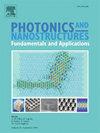Fabry-Perot cavity colorful reflective electrochromic device based on metal and tungsten trioxide
IF 2.5
3区 物理与天体物理
Q3 MATERIALS SCIENCE, MULTIDISCIPLINARY
Photonics and Nanostructures-Fundamentals and Applications
Pub Date : 2025-02-01
DOI:10.1016/j.photonics.2025.101352
引用次数: 0
Abstract
The realization of colorful effects based on inorganic electrochromic materials has always been a focus of research in the field of electrochromism. In recent years, colorful electrochromic devices based on Fabry-Perot cavity have received a lot of attention. This article uses three metals (chromium, copper and tungsten) and tungsten trioxide to form Fabry-Perot cavity, and tests these electrochromic devices (ECDs). The results show that Fabry-Perot cavity electrochromic devices based on these three metals can achieve colorful effects, among which ECD using tungsten as reflector has the best performance, with an optical modulation range of reflectivity of 27.67 %. The CIE color coordinates change from (0.235, 0.300) to (0.241, 0.181), and the response times for coloring and bleaching are 4.0 s and 6.1 s, respectively. ECD using chromium as reflector is similar to ECD using tungsten as reflector in reflectance spectra, ECD using copper as reflector has a fast response speed but performs poorly in terms of cycle life. By comparing the differences in device performance caused by three types of metal reflective layers, we believe that metals with strong reflection, good conductivity, and chemical stability can perform better in such electrochromic device.
求助全文
约1分钟内获得全文
求助全文
来源期刊
CiteScore
5.00
自引率
3.70%
发文量
77
审稿时长
62 days
期刊介绍:
This journal establishes a dedicated channel for physicists, material scientists, chemists, engineers and computer scientists who are interested in photonics and nanostructures, and especially in research related to photonic crystals, photonic band gaps and metamaterials. The Journal sheds light on the latest developments in this growing field of science that will see the emergence of faster telecommunications and ultimately computers that use light instead of electrons to connect components.

 求助内容:
求助内容: 应助结果提醒方式:
应助结果提醒方式:


